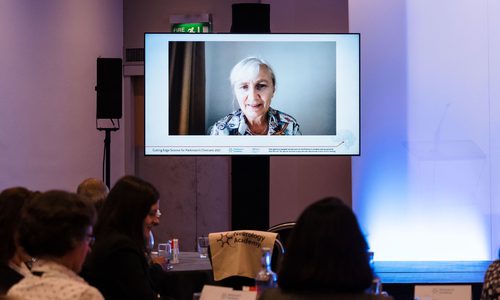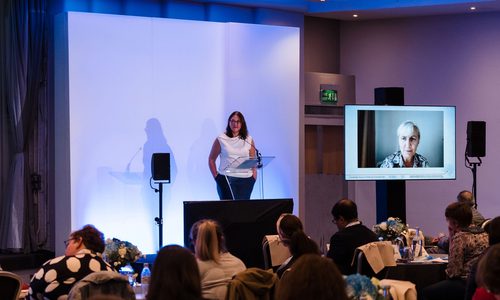Sleep in Parkinson's disease – PD Cutting Edge Science
Event reports
This session is part of a series of write-ups on Parkinson's Cutting Edge Science for Clinicians 4; the conference summary for which is here. The conference was chaired by Dr Emily Henderson and Prof Annette Hand.
Prof Claudia Trenkwalder, President of The International Parkinson and Movement Disorder Society, presented an excellent and succinct overview of sleep in Parkinson's.
Key messages were helpfully summed up on Twitter by Dr Emily Henderson via @DrEmHenderson (fig 1).
REM sleep-behaviour disorder diagnosed via bed partner. Across disease, half experience, ⬆️ risk with age. Potential ++ as a biomarker.
— Emily Henderson (@DrEmHenderson) October 5, 2021
Rx:
✅clonazepam
✅Melatonin
❌Avoid SSRI
❌Cannabidiol not effective.
✅Exercise helps
Figure 1: Tweet from @DrEmHenderson during Claudia's talk (handle @ctrenkwalder1)
Sleep disturbance is complex in Parkinson's
Claudia shared the complexities of sleep disturbances in Parkinson's due to the number of contributing, overlapping and interlocking elements which all impact on it (fig 2).

Figure 2: Factors contributing to sleep disturbance in Parkinson's
Insomnia is common
Claudia observed that insomnia is common in people with Parkinson's, with many people experiencing insomnia up to four years before being diagnosed with Parkinson's itself (Shrag et al 2015), whilst a number of risk factors indicate whether a person with Parkinson's is more likely to experience insomnia (Wallace 2020).
In terms of treatment for insomnia, Wallace et al's review of evaluation and management of insomnia in Parkinson's recommend a different form of treatment for those in under 65's than for those who are elderly (over 65) due to the increased risk of falls which come with the drowsiness of the medicines prescribed to under 65's.
Nocturnal akinesia is complex
Claudia referred to a helpful paper (Bhidayasiri & Trenkwalder 2018) in understanding Parkinson's and nocturnal hypokinesia.
Claudia Trenkwalder
She highlighted the difficulties that people face in their nocturnal movements, from turning over in bed, to getting up to use the toilet or fetch a glass of water (fig 3).

Figure 3: Diagram regarding the difficulty of turning in, or getting out of, bed for people with Parkinson's (taken from 'Getting a good night sleep? The importance of recognizing and treating nocturnal hypokinesia in Parkinson’s disease' (Bhidayasiri & Trenkwalder 2018)
Claudia Trenkwalder
Claudia recommended considering if a person needs their medication tailoring to support their nocturnal movements, including adding a nighttime infusion of apomorphine if they are using a pump, and she provided references to helpful studies which examine this such as RECOVER (Vallderiola 2015, Chaudhuri 2013).
She recommended theParkinson's disease sleep scale (PDSS) as a useful form of assessment to ascertain if additional support, medication or other management is needed to improve people's function and ability at nighttime.
Other impactful symptoms
Claudia noted that a significant tremor often experienced during wakeful 'off' states which prevent people from being able to fall asleep again at night.
Claudia Trenkwalder
She also noted that restless legs syndrome (RLS) can impact quality sleep particularly in the early phases of Parkinson's, accompanied by the urge to get up and move around to reduce the discomfort. Claudia noted that restless legs syndrome is an early feature of Parkinson's and that people with Parkinson's often share their RLS affects them only in the hours before they are falling asleep, rather than at other times of the day as is seen in idiopathic RLS.
She highlighted a recent American study finding a significantly increased risk of developing Parkinson's in elderly men with newly developed restless legs syndrome during their later years, with the newly presenting RLS predating a Parkinson's diagnosis by 4 years (Wong 2014).
REM sleep behaviour disorder
Claudia shared that REM sleep behaviour disorder (RBD) is most commonly diagnosed through the bed partner and that, across the trajectory of Parkinson's, around half of individuals will experience this, with risk increasing as people age (Sixel-Doring et al 2011, Baumann-Vogel 2020).
At the very start of her talk, discussing James Parkinson's early observations of sleep in people with Parkinson's, she noted that his comments on tremor and movement during sleep may be the first documented observations of REM sleep behaviour disorder (fig 4).

Figure 4: Slide detailing sleep-related observations from James Parkinson's 'An Essay on the Shaking Palsy' (1817)
Claudia noted an important differential diagnosis to RBD is nocturnal hallucinations which may be distinct from RBD yet appear similar in the way they impact a person's sleep.
She noted the internal classification of RBD (Sleep Disorders 2014) and described RBD as:
Shouting, laughing or any vocalisation in the middle of the night or early morning
Complex movements, aggressive behaviour during sleep
Violations of the bed-partner or the patient during sleep
No quiet nights
Frequent interruptions during sleep
Claudia stated that 'RBD is not only a trademarker but also a progression marker' in Parkinson's, noting that REM without atonia increases over time in correlation with RBD and went on to explain how and why this happens (Breen 2017).
She explained that recent studies note a conversion from idiopathic REM sleep behaviour disorder to Parkinson's disease in 6% of cases (Postuma et al 2019) but lamented that whilst we know that that a number of people will 'convert', we cannot know who these people will be.
Claudia Trenkwalder
In discussing management of RBD, she highlighted that medications that ought to be reduced or removed are as important as those to add, specifically noting cholinergics as a risk medication group.
Claudia shared that exercise is beneficial in managing optimal sleep in Parkinson's with a recent study finding that one hour of exercise improves sleep in Parkinson's (Kumar 2020).
Claudia closed her session by discussing the pharmacological treatment options for a range of sleep-related Parkinson's symptoms (fig 5).

Figure 5: Sleep disorders treatment summary - Claudia's slide

This meeting is designed and delivered by the Parkinson’s Academy and sponsored by BIAL Pharma. The sponsor has had no input into the educational content of this meeting.
Related articles
'The things you can't get from the books'
Parkinson's Academy, our original and longest running Academy, houses 23 years of inspirational projects, resources, and evidence for improving outcomes for people with Parkinson's. The Academy has a truly collegiate feel and prides itself on delivering 'the things you can't get from books' - a practical learning model which inspires all Neurology Academy courses.






